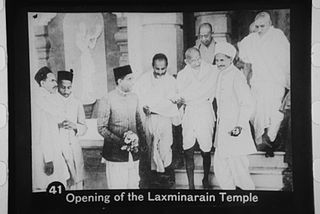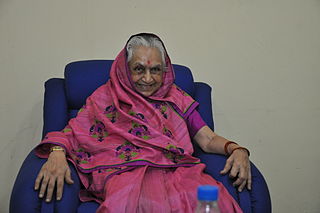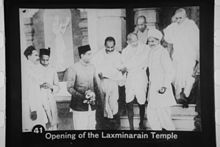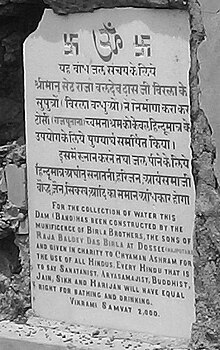
Ghanshyam Das Birla was an Indian businessman and member of the Birla Family.
Birla Corporation Limited is an Indian-based company of the M.P Birla Group, founded by Ghanshyam Das Birla in the late 1910s and carried on by Madhav Prasad Birla.

The Aditya Birla Group (ABG) is an Indian multinational conglomerate, headquartered in Mumbai. The group has a presence in 36 nations and a combined annual revenue of $75 billion, over 50% of which is derived from its overseas operations. The group's business interests include metals, cement, fashion and retail, financial services, renewables, fibre, textiles, chemicals, real estate, trading, mining, and entertainment.

Krishna Kumar Birla was an Indian industrialist of the Birla family.
Rameshwar Das Birla (1892–1973) was an Indian entrepreneur. He was second son of Baldeo Das Birla and the father of Madhav Prasad Birla and Gajanan Birla. He is known for founding hospitals & educational institutions in Mumbai, Kolkata and Pilani.

Baldeo Das Birla was an Indian entrepreneur. He contributed to the establishment of the Medical College Calcutta, and also built the Laxminarayan Temple, Delhi, also known as Birla Mandir, which was inaugurated by Mahatma Gandhi in 1939.

Kumar Mangalam Birla is an Indian billionaire industrialist, philanthropist, and the chairman of the Aditya Birla Group, one of the largest conglomerates in India. He is the chancellor of the Birla Institute of Technology & Science, Pilani and ex-chairman of Indian Institute of Management Ahmedabad. According to Forbes, he has an estimated net worth of US$19.6 billion, as of March 2024 making him the 7th richest person in India.

Ganeriwala family are a Marwari family, connected with the financial, social and cultural history of Rajasthan. Through the 19th and early 20th century, members of the family were financiers and money lenders in the princely state, and they served as treasurers for the royal families of the state. A common trait among the traditional banking families of Rajasthan, members of the Ganeriwala family have been credited for the construction of various Hindu temples and haveli’s in Rajasthan.

Birla School Pilani, also known as BSP & BHS in Pilani, Jhunjhunu district, Rajasthan is a boarding school in India. Earlier it was known as Birla Senior Secondary School. The school is considered to be a royal school along with a few other schools in India, due to its long patroness history and has educated some well known royal families of India during British Raj. It also has a prominent alumni network in India due to its rich old history.

Basant Kumar Birla was an Indian businessman of the Birla family. He was chairman of the Krishnarpan Charity Trust, BK Birla Institute of Engineering & Technology (BKBIET) and various educational trusts and institutes.

Aditya Vikram Birla was an Indian industrialist. Born into one of the largest business families of India, he oversaw the diversification of his group into textiles, petrochemicals and telecommunications. He was one of the first Indian industrialists to expand abroad, setting up plants in Southeast Asia, the Philippines and Egypt. His net worth was estimated at £250 million by 1995. His death at the age of 51 left his young son Kumar Mangalam Birla in charge of his group of companies.
Bania is a mercantile caste mainly from the Indian states of Gujarat and Rajasthan, with strong diasporic communities in Uttar Pradesh, Madhya Pradesh, West Bengal, Maharashtra and other northern states. Traditionally, the main occupations of the community are merchants, bankers, money-lenders, and owners of commercial enterprises.
Gita Piramal is an Indian writer and business historian.
Sheth Jugal Kishore Birla was a scion of the Birla family and the eldest son of Baldeo Das Birla. He was a noted industrialist, philanthropist and vocal supporter of Hindu philosophy.
Rajashree Birla is an Indian philanthropist. She is the wife of the late Aditya Birla. After her husband's death in 1995, Rajashree began working in CSR and charity sectors, developing a large philanthropic organization funded by her family. In 2011, the Government of India honoured her with the Padma Bhushan, the third highest civilian award, for her services to society.
Ganga Prasad Birla, born in Benares was an Indian industrialist. Ganga Prasad Birla belonged to Maheshwari Marwari Community from Rajasthan.

Sarala Birla was an Indian Businesswoman prominent member of the Birla family of Indian industrialists. She took interest in public education and, along with her husband, is credited with having co-founded about 45 educational institutions supported by her family's conglomerate.
Rai Bahadur Sir Badridas GoenkaCIE was an Indian industrialist and business tycoon who served as the Chairman of the Imperial Bank of India from 1933 to 1955 and the first Chairman of the State Bank of India upon its formation in 1955.
Tarachand Ghanshyamdas was a famous Marwari trading firm that flourished from 1791 to 1957. It is believed to have been responsible to introducing many of now famous Marwari clans from Shekhawati to national and international business field. The grandfathers of both G.D. Birla and Lakshmi Mittal worked for great Tarachand Ghanshyamdas while grandfather of Raja Baldeo Das Birla worked at the great Ganeriwala Firm
Brij Mohan Birla was one of the scions of Birla family and an industrialist and philanthropist. He was the youngest and 4th son of Baldeo Das Birla. He was chairman of Hindustan Motors, Ruby General Insurance, India Exchange Ltd, NBC Bearing and was on board of several other Birla companies. He founded Hindustan Motors in 1942 and NBC Bearings in 1946. CK Birla Group is successor to his branch of Birla family. He was president of Indian Chamber of Commerce in 1936 and the Federation of Indian Chambers of Commerce & Industry for year 1954.











